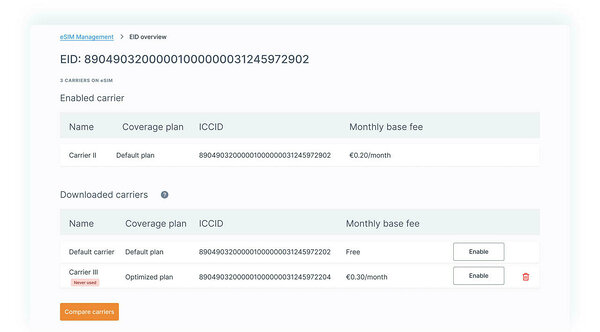Every cloud has a silver lining. While 2020 has been one hell of a year, it gave us a chance to focus on improving our key value offering — 1oT Terminal.
And we're not just talking tweaks here or there; we're talking about the whole nine yards.
To recap, then we completely revamped the user interface of our connectivity management platform. Product redesigns can be risky and time-consuming, but we had many good reasons for doing it:
-
Our first version wasn't really designed. As a start-up, we bootstrapped something together on top of each page and module and flow. It was becoming more challenging to create a cohesive experience for our customers.
-
Our product is getting more complicated. We needed to take a step back to ensure that the features are easily usable. There's zero value in a feature that users struggle to understand.
-
More users mean more feature requests and expected functionality. We wanted to get our house in order to make sure our design systems and front-end architecture support sustainable scaling.
Connectivity management isn't about a single SIM in an IoT device. With thousands of SIMs to manage, the user journeys on the platform must be dead simple.
Let's look at some key improvements we made.
SIMs view
Here we go. Our users spend 90% of their time on the SIMs view page. That’s where they manage the SIMs. Be it organizing their SIMs, setting data limits, or troubleshooting an issue.
We needed to be careful not to brick an essential page in Terminal.
What are the key issues we addressed here?
-
We gave our users the ability to order columns with a simple drag and drop interaction. This way, they can customize the big table with all the relevant information to their preferences.
-
Our users send a lot of SMSes to their SIMs. We noticed that usually, it’s the same SMS content to configure the device. That’s why we created SMS templates. Whenever they send a SMS, users can save it as a template and don’t need to type in the same content ever again.
-
The core of 1oT’s business is mobile data. But IoT devices also communicate through SMS. Therefore we introduced a SMS limit to safeguard against the device accidentally sending too many SMS.
With the SIMs view behind us, let’s look at the SIM detail view. That’s the page where the users can see the individual information for each SIM.
SIM detail view
Here our clients come to look at the details of each SIM. Almost always, they want to understand the SIM's behavior and what has happened before.
That's why we put the main emphasis on the following features:
-
Users can add comments to usage history. These are free-form comments and used to put down notes like "updated device firmware" or "reset IoT module." The remarks can tell why SIM's consumption increased or decreased, no need to play the guessing game six months later.
-
All SIM-related events are visible. Again, by displaying who changed the SIM status and when the data limit was increased, we reduce the need for our users to guess what happened. The automated logs help figure this out instead.
eSIM management
Besides UI improvements, we introduced something that no connectivity management platform supported before.
Welcome, 1oT eSIM Management tool!
1oT is aggregating different eSIM profiles to its eSIM, which is why our users also need a useful interface for managing their eSIMs.
eSIM Management tool gives 1oT clients full freedom to choose the telecom service they wish to use. In 1oT Terminal, clients can first see the pricing and network coverage for each eSIM profile. After finding the right match, they can enable the service by themselves.
It's easier said than done, and we had many challenges to introduce a simple user flow.
-
We needed to be crystal clear about the terminology.
-
The entire flow of swapping for a new profile has many 'what-ifs". Making sure that users understand the flow and consequences of their actions was our number one priority.
Also, clients can have many profiles on their eSIMs. That's why they must understand which profiles are enabled and which are downloaded.
For example, 1oT Terminal shows if there are profiles that have never been used and suggests deleting that profile.
Users also have a full overview of all eSIM transactions — what was successful and what failed. eSIM transactions assume various systems are working together smoothly, and it's paramount that 1oT clients have visibility into those transactions.
At 1oT, we believe that eSIM allows taking IoT deployments to a new level. It makes it easier for IoT companies to reduce the risk of failed projects because of connectivity issues.
New features from 2020
2020 was a busy year for 1oT’s product development department. Besides overall user experience improvements, we rolled out many features that make 1oT Terminal a more powerful connectivity management platform:
-
Future events app allows scheduling SIM actions in the future.
-
Analytics is useful for gathering insights about data consumption and patterns.
-
MS Teams integration allows our clients to receive SIM-related information directly to their Teams chat.
Still, many challenges lie ahead for the next year. You might wonder what our priorities are going forward.
1oT SIMs produce tons of insights, and we want to take advantage of that by building an AI-powered predictive alerts system. It means that 1oT Terminal can notify our clients of issues before someone notices some malfunction or errors. We are currently testing the beta version of these predictive alerts, which learns from data consumption patterns.
To automate SIM management more, we're working on a workflow automation engine. It means that the user sets triggers that carry out tasks according to their instructions.
For example, if a SIM has reached 70% of its data limit, raise the data limit. Or, if an eSIM transaction succeeds, change the data package. We want to take the manual hassle out of daily SIM management operations and simplify repetitive and time-consuming work.
Onwards and upwards from here! If you're keen to learn more about 1oT and our eSIM solution, get in touch with us by writing to sales@1oT.com.

.png)








